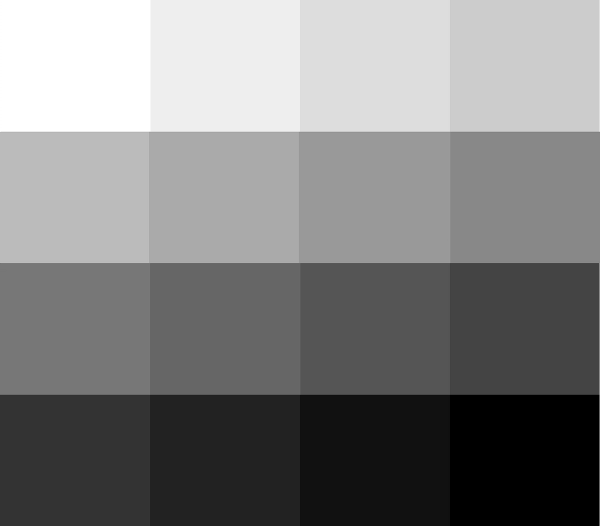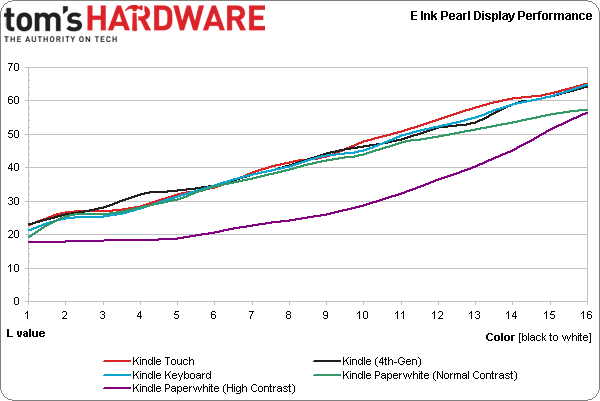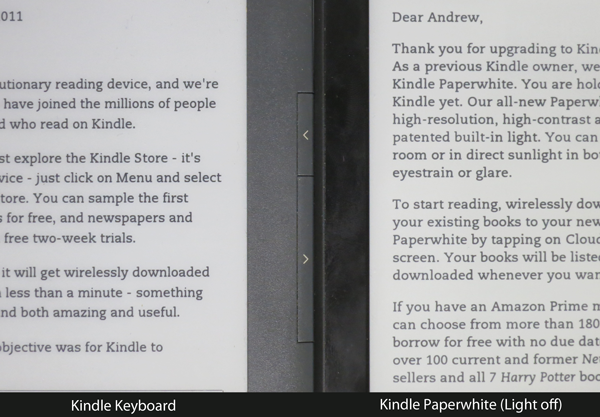Amazon Kindle Paperwhite Review: The Best E-Book Reader?
Results: Are Some E-Book Displays Better Than Others?
We’ve measured varying levels of contrast between different E Ink-based displays. In fact, the fourth-generation Kindle's display actually seemed worse than its predecessor's.
At first, we couldn’t be sure if this was an optical illusion or an actual step backward. However, like actual paper, E Ink-based displays require reflected light to read text. So, we took a cue from our exploration of printer paper (Tom's Hardware Benchmarks Inkjet Printer Paper!), where our NIST-certified i1Pro calibration tool allowed us to measure paper's color performance. The i1Pro contains a finely-calibrated light source that illuminates a color patch with a fixed amount of light, removing our eyes as a variable.
We can apply that same methodology to e-book readers because E Ink-based displays operate on the same principle.
The benchmark process is fairly simple. Since E Ink Pearl supports 16 different shades between black and white, we're using Photoshop to create monotone backgrounds starting from #000000 (the six-digit hexadecimal number for black) and progressively increasing the hue until reaching #FFFFFF (white). The end is 16 evenly-spaced shades, from white to black. We then use our spectrophotometer's printer measurement mode to take color space readings.
The L value on the Y-axis is traditionally referred to as the "lightness of a color." This is measured on a 0-to-100 scale, where higher values indicate lighter colors. So, true black would have an L value of 0, while pure white has a value of 100.
According to our previous results, the fourth-generation Kindle suffered a slight reduction in contrast compared to previous models. Subjectively, the Kindle Paperwhite appears very close to the third-generation Kindle (known as the Kindle Keyboard), and our benchmark results largely concur, with a couple of caveats. First, solid black appears slightly darker on the Paperwhite compared to previous Kindles. Unfortunately, lighter shades also appear a tad darker on the Paperwhite.
Interestingly, Amazon's Kindle Paperwhite lets you set the contrast on a five-point scale. This is a new feature unique to the company's e-book reader flagship. By default, the Paperwhite is set to the middle point, which we’re calling “normal contrast.” Notched up to “high contrast,” you’ll see a bigger difference between pure black and true while. However, this comes at the expense of the shades in between.
Get Tom's Hardware's best news and in-depth reviews, straight to your inbox.
That's not the end of the story, though. There's a long-running debate about the quality of E Ink screens. Specifically, is there actually a difference between Kindle generations, or are our eyes playing tricks on us? Our benchmarks prove a difference exists using hard data. But that doesn't eliminate another possibility: quality variation. To quote our fourth-generation Kindle review:
“We called up E Ink Corporation to ask if this was a batch-related issue, and was told that this is most likely due to Amazon choosing a particular grade of display panels.”
While we discussed many aspects of e-book readers in that review, that line in particular stirred up quite a lot of controversy. We want to once again say that it is possible to purchase two e-book readers of the same model and get a different experience. It’s not just in your head. E Ink uses a chip called Broadsheet to control its panels, and the following is a quote from GPL source code in the Linux broadsheetfb driver:
Broadsheet is a framebuffer device. It is slightly different from a typical framebuffer controller that drives a normal TFT-LCD display. Most E-Ink display panels require a waveform in order to function. That is, in order to drive the state of a pixel to black, gray, or white, a specific waveform is utilized. Basically, that waveform represents the specific E-field wiggling needed to get the pixel to its optimal state given current temperature, and its previous state. TN/IPS-LCDs use a similar concept but the driving waveform is sufficiently simple that it is internalized in the TFT source/gate driver. These E-Ink waveforms are specific to a production batch. That is, a batch of display films are produced, then they get characterized and a waveform is generated for that batch. Broadsheet, typically, is attached to its private SPI flash which is then flashed with this waveform. Users won't be able to see the waveform and typically won't ever need to know about it. If however, the display panel attached to broadsheet is changed out, then they will need to update their waveform. That would typically be done at a factory or repair facility rather than by a user.
In a nutshell, once a batch of E Ink displays are manufactured, they go through quality control where a set of unknown characteristics get analyzed. This data is then used to generate a waveform for that batch. The waveform itself represents the specific electrical technique used to transition from black to white (and vice versa). While E Ink manufactures its panels to a tight spec, it’s very possible to get displays at the outer limits of what might be considered acceptable.
Does that mean our benchmarks are moot?
Yes and no. We’ve benchmarked multiple Kindles, and there still appears to be a slight difference between certain models. Fortunately, if you are having a problem, Amazon’s free return policy makes a replacement rather painless, so the possibility of getting stuck with a lemon shouldn't get in the way of your purchasing decision.
Current page: Results: Are Some E-Book Displays Better Than Others?
Prev Page Frontlighting, Examined Next Page The Paperwhite Under Various Lighting Conditions-
Stimpack I've been contemplating whether I should buy the Kindle Fire or the Paperwhite for a couple of weeks now. While this summation of the Paperwhite and its features helped shed some light (heheh.) on its selling points, I still feel no closer to a decision.Reply
Nevertheless, it was an entertaining read! In fact, it's made me register an account here. I can't wait to read more articles like this. Fun stuff! -
kartu slomo4shoI am still waiting for a Kindle with SD or mSD expandability.It's called "Sony Reader T2". It runs Android. And it's rooted.Reply
And you are not bound to Amazon's store with it, even non rooted you can burrow books from electronic libraries and read common formats like EPUB. -
Mark Matthews dirtyferretive read several books on my kindle fire HD, often for hours at a time, and never had an issue with eye strain or battery life. In fact i prefer reading on the kindle HD then a regular book.Reply
The one advantage of e-ink readers like the traditional kindle, is you can read it in daylight. I have an iPad and spend a lot of time chilling on the back deck during the summer, and I have to go through a lot of seating arrangements to minimize the glare so that I can see the iPad. Ordering a new Kindle just for this purpose. -
ubercake I like my Paperwhite. It's really easy on the eyes and does not have all the distractions of a tablet. When I want to read, I use this. It's great under sunlight, but does in fact have a sort of mild glare under artificial overhead lighting conditions. Nothing bad, though. You can just tilt it a little one way or another to elimnate the glare. What is especially great is when it's dark and you're a passenger on a car ride. You can continue to read. The lighting is great and doesn't fatigue your eyes like an LED or LCD screen.Reply
Cloud sync is great too for those times when I don't have my Kindle with me. I can pick up my phone with my Kindle app and start reading right where I left off on my Kindle and vice versa.
Also, the battery lasts significantly longer (we're talking months of daily reading) if you just shut off the wireless connection when you're not downloading any books or sync-ing to the cloud. If you leave the wireless connection on full-time, you need to recharge after about 4 weeks. -
tridon I really fell in love with the graphs over Display Performance that showed the differences between the Kindles. Please use this the next time you review a Kindle as well. It would be valuable extra information when deciding whether or not to buy a new version a year or two :) It will be very interesting to see if the Paperwhite has improved the clearness in a year.Reply
Great article! *thumbs up the article* -
tridon StimpackI've been contemplating whether I should buy the Kindle Fire or the Paperwhite for a couple of weeks now. While this summation of the Paperwhite and its features helped shed some light (heheh.) on its selling points, I still feel no closer to a decision. Nevertheless, it was an entertaining read! In fact, it's made me register an account here. I can't wait to read more articles like this. Fun stuff!Reply
If you plan to read a lot where there is natural light (in the sun or shadow outside or near windows, etc) I would really recommend the Paperwhite. Just my personal preference. My eyes are really having a hard time reading on a tablet under such conditions. If you mostly read where you can control the lightning condition the Paperwhite would still be easier on the eyes, but there is no longer a real problem reading on the tablet =) -
I've being using 3 models of kindle. The back light on the latest one is great but the touch screen... ARG, my god, a pain in the but. Get me simple buttons, I miss my buttons SO MUCH.Reply
If you are using your tablet to read, not comment, not surfing the web, not playing, reading, all you need is a previous/next page. The touch screen is not flawless, it will not work then you will skip 3 pages. Then you'll put your kindle on the coach and something will touch the screen and...
Bring back the button please! -
shadowfamicom hadignyI've being using 3 models of kindle. The back light on the latest one is great but the touch screen... ARG, my god, a pain in the but. Get me simple buttons, I miss my buttons SO MUCH.If you are using your tablet to read, not comment, not surfing the web, not playing, reading, all you need is a previous/next page. The touch screen is not flawless, it will not work then you will skip 3 pages. Then you'll put your kindle on the coach and something will touch the screen and...Bring back the button please!Reply
Yes I am really pretty sick of the lack of buttons in favor of touch screens. Part of the reason I never really used a first gen iPod touch that someone gave me. If I am walking and have my MP3 player in my pocket... I want it to have buttons, for switching songs and volume up and down. Don't even get me started on phones without physical keyboards.



